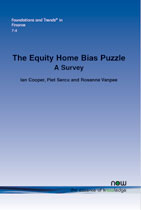The Equity Home Bias Puzzle: A Survey
Ian Cooper, London Business School, UK, icooper@london.edu , Piet Sercu, KU Leuven, Belgium, piet.sercu@kuleuven.be , Rosanne Vanpée, KU Leuven and HU Brussels, Belgium, rosanne.vanpee@kuleuven.beAbstract
Home bias – the empirical phenomenon that investors assign anomalously high weights to their own domestic assets – has puzzled academics for decades: financial theory predicts that an internationally well diversified portfolio of stocks and short-term bonds can reduce risk significantly without affecting expected return. Although the globalization of international equity markets has increased international investments, equity portfolios remain severely home biased today, and no single explanation seems to solve the puzzle completely. In this paper, we first provide a thorough description of the equity home bias phenomenon by defining, discussing, and applying the competing measures and presenting some estimates of the costs of under–diversification. Second, we evaluate the explanations for the equity home bias proposed in the literature such as information asymmetries, behavioral aspects, barriers to foreign investment, and governance issues, and conclude that each explanation on its own falls short, suggesting that the equity home bias probably reflects a combination of factors. Lastly, we review the implications of international under–diversification for portfolio formation and the cost of capital of companies.
The Equity Home Bias Puzzle
The Equity Home Bias Puzzle: A Survey puts into perspective one of the strongest and most persistent empirical phenomena in finance: equity home bias. The authors not only provide a thorough review of the competing measures of home bias and the explanations for the equity home bias proposed in the current literature, but also lay out the implications of international under–diversification for portfolio formation and the cost of capital of companies.
The Equity Home Bias Puzzle: A Survey is organized as follows. After an introduction, Section 1 defines the equity home bias puzzle and explains why it is important. Section 2 reviews the two main methods used to quantify equity home bias, the positive and normative approaches, and shows how alternative home bias measures can be constructed using variations or combinations of these two methods. In Section 3 the authors explain the economic significance of under–diversification by estimating the total implied discount and then go on to review the various explanations for equity home bias – ultimately concluding that each explanation on its own is not sufficient, suggesting, in Section 4, that equity home bias reflects a combination of factors. Section 5 lays out the implications of home bias for investment and corporate finance and Section 6 concludes that no version of standard portfolio theory alone has been able to explain it.
